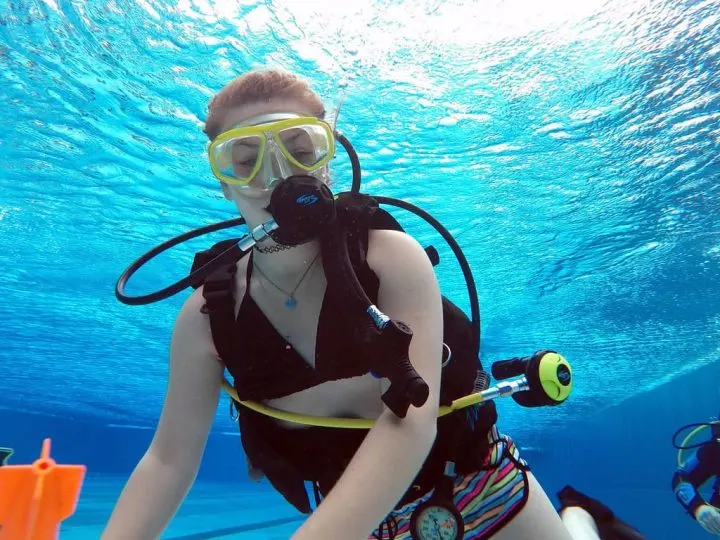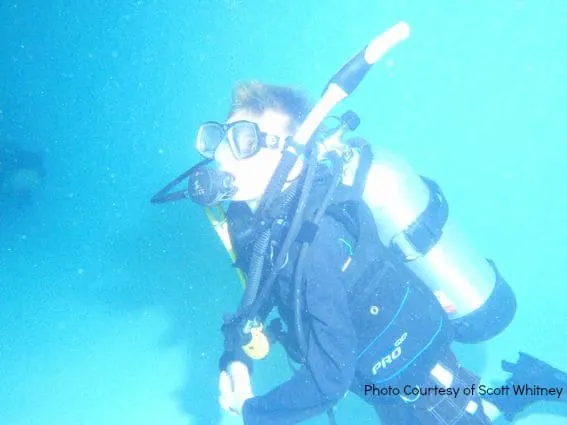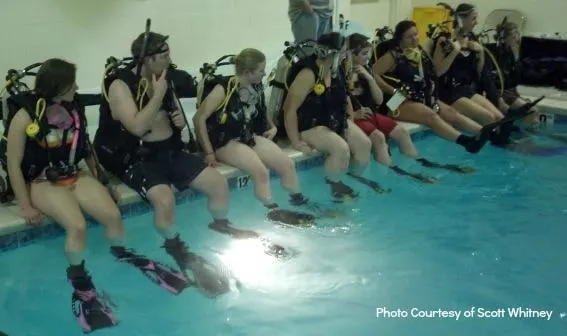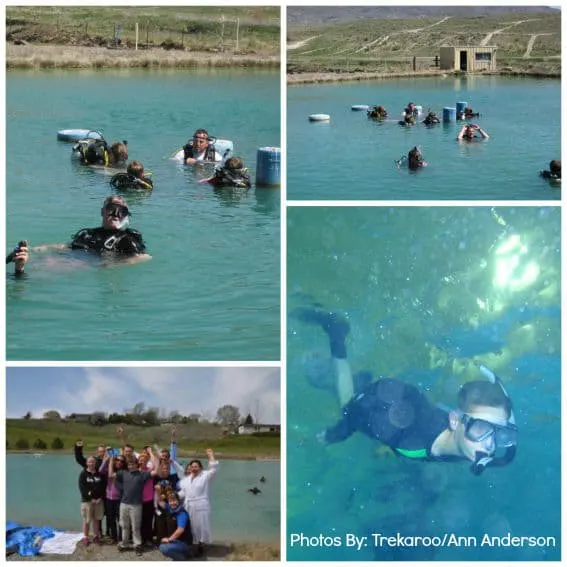Before I share my story about how my son and I became open water scuba certified, you must know that I’m claustrophobic and I hate water on my face. In fact, I don’t even swim. My swimming experience has been to doggy-paddle just so I can keep water off of my face. So why would I want to learn to scuba dive? If you’re a parent, you already know the answer to that question. I learned to scuba dive simply because my 12-year-old son asked me to become open water scuba certified with him. That’s the kind of thing you do as a parent.
Scuba Open Water Certification with PADI
Not just anyone can jump in the water with a scuba tank strapped to their backs. In fact, there are many technical and safety skills that must be mastered and certified by an open water dive certification agency before you’re even permitted to own or rent a scuba tank. My son and I turned to the well-known and well-respected Professional Association of Diving Instructors (aka PADI) to earn our open water certification. PADI offers scuba programs specifically targeted to kids. In fact, PADI invites kids as young as 8 to participate in various introductory scuba diving programs. Kids as young as 10 years of age can complete junior open water scuba certification. Plus, PADI open water certification centers are located nationwide; even in landlocked Utah where we completed our certification.
There are four main components to completing open water scuba certification: classroom learning, equipment considerations, confined water dives, and finally, open water dives.
Classroom Learning
Classroom learning can be completed in an actual classroom with a PADI instructor, or online through PADI’s exclusive eLearning courses. We opted for the convenience of the eLearning courses which covered topics such as use and care of scuba equipment, underwater hand signals, effects of pressure on the body, safety, and dive planning. The online course was presented in a narrated slide format with illustrations and photos. As we worked our way through the coursework, I felt like we were witnessing the good (i.e. pretty fish), the bad (i.e. decompression sickness), and the ugly (i.e. nitrogen narcosis) of scuba diving. Honestly, the eLearning course illustrations escalated my anxiety about scuba diving. But despite my anxieties, we completed all six chapters of the online coursework within one week and demonstrated our proficiency by passing online tests and an in-classroom knowledge review test.
So what was our impression of PADI eLearning?
Me: I had a scuba nightmare each night following the completion of an eLearning chapter.
Son: Can that really happen to your lungs underwater?
Me: What am I getting us into?
My only regret with our eLearning experience is that we did not complete the eLearning in conjunction with our confined water dives. The eLearning portion of our certification would have made much better sense and my anxieties would have lessened if we had completed an eLearning section then followed with the applicable confined water dive class. I would highly suggest that eLearning participants contact their dive centers before beginning the eLearning coursework in order to arrange concurrent eLearning and confined water dives.
Equipment
PADI dive centers provide most of the scuba equipment that you’ll need during confined water dives. However, each participant must have their own mask, snorkel, and fins.
As a scuba equipment novice, I found it necessary to turn to a diving expert when considering equipment. So I turned to the infamous Captain Jacques Yves Cousteau, inventor of the first Aqua Lung. Aqua Lung offers safe and high quality scuba gear that is revered in the diving community. We loved our Aqua Lung gear. In fact, our Slingshot Aqua Lung Fins contained more revolutionary contraptions than a ballistic missile submarine; power bands, gear shifts, flex joints, plus they looked pretty darn cool. Our Look 2 Aqua Lung masks provided a wide areal viewing, plus they were comfortable (even for a claustrophobic like me).
So what was our impression of Aqua Lung gear?
Me: If I’m going to make a fool of myself, I might as well look good doing it.
Son: When can we jump in, this stuff is cool.
Confined Water Dives – Pool Time
During our first confined water class we were asked to prove our physical abilities by treading water for 10 minutes. I guess all my doggy-paddling experience was finally paying off. Then we were asked to snorkel 300 yards. I found that it really wasn’t too terrible getting my face wet for 300 yards because each time I lapped, my son held his hands underwater signaling my lap count and cheering me on with his hand-signs. Once our physical abilities were proven, we were taught how to properly connect and wear scuba gear. Hoses, gauges, and snorkel, oh my. I felt like I’d just been attacked by an octopus. We were now ready for our first confined water dive.
Our PADI center diving pool had two areas; a shallow “learn new skills” area, and a 12 foot deep “show off new skills” area. Pool time consisted of our instructors demonstrating a new skill above water, and then performing the same skill underwater while we watched. The instructors then asked each of us to perform and perfect these skills underwater. Skills ranged from “flood your mask with water and clear it” to “we’re going to turn off your air tank and you’re going to have to ask a buddy for air”. We ran through several diving emergency scenarios and our instructors expertly guided us through the proper procedures to handle each of these situations.
So what was our impression of confined water diving skills?
Me: You want me to do what? But that’s why I’m wearing this waterproof dive mask and scuba tank full of oxygen. I don’t like water in my face and I love oxygen. Okay, I’ll do it….but please don’t ask my little boy to do it.
Son: I can do that, no problem.
Open Water Dives
So where do you go to open water certify in landlocked Utah? The answer is anywhere you can find warm water year round. We headed for the 97 degree geothermal heated water at Utah’s Belmont Springs. Here our instructors would require us to complete four open water dives and proficiently demonstrate certain water skills. I knew we were prepared. We had already perfected the mandatory scuba skills in confined water, now our only roadblocks would be limited visibility and a few minnows swimming around.
So what were our open water dive thoughts?
Me: I could feel my confidence increase with each dive. Why did I ever consider myself claustrophobic? This geothermal heated water might even be good for my skin and wrinkles – I’m soaking my face in this stuff!
Son: I did it! Do we really get a formal open water scuba certification card with our pictures on it? I want to become a master diver! When can we go to the ocean Mom? Those minnows kept tickling my legs underwater! When can we go diving again Mom? Let’s calculate our diving pressure group. Can we sign up for the advanced open water class Mom? I’m keeping my diving log book in a special place. When do we get our certification cards Mom?
Check out these diving vacations spots:
Special thanks to PADI, the Eastern Mountain Sports, and Aqua Lung for providing the training and equipment necessary for my son and I to complete our open water dive certification.
![]()





